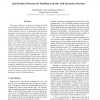Free Online Productivity Tools
i2Speak
i2Symbol
i2OCR
iTex2Img
iWeb2Print
iWeb2Shot
i2Type
iPdf2Split
iPdf2Merge
i2Bopomofo
i2Arabic
i2Style
i2Image
i2PDF
iLatex2Rtf
Sci2ools
133
Voted
CVPR
2012
IEEE
2012
IEEE
Sum-product networks for modeling activities with stochastic structure
This paper addresses recognition of human activities with stochastic structure, characterized by variable spacetime arrangements of primitive actions, and conducted by a variable number of actors. We demonstrate that modeling aggregate counts of visual words is surprisingly expressive enough for such a challenging recognition task. An activity is represented by a sum-product network (SPN). SPN is a mixture of bags-of-words (BoWs) with exponentially many mixture components, where subcomponents are reused by larger ones. SPN consists of terminal nodes representing BoWs, and product and sum nodes organized in a number of layers. The products are aimed at encoding particular configurations of primitive actions, and the sums serve to capture their alternative configurations. The connectivity of SPN and parameters of BoW distributions are learned under weak supervision using the EM algorithm. SPN inference amounts to parsing the SPN graph, which yields the most probable explanation (MPE) ...
Related Content
| Added | 28 Sep 2012 |
| Updated | 28 Sep 2012 |
| Type | Journal |
| Year | 2012 |
| Where | CVPR |
| Authors | Mohamed R. Amer, Sinisa Todorovic |
Comments (0)

